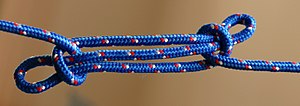Knots/Seizing knots/Sheepshank
The sheepshank is a type of knot (or, more accurately unknot) that is used to shorten a rope or take up slack. The knot has several features which make it suitable for this purpose:
- It provides two loops, one at each end of the knot which can be used to pass another rope through
- The knot remains secure under tension; the coarser the rope the more secure it is (see Disadvantages, below)
- The knot falls apart easily when tension is removed
| Sheepshank | |
|---|---|
 An unloaded sheepshank tied in nylon rope. | |
| Category | shortening |
| Efficiency | 46% |
| Releasing | Non-jamming |
| Typical use | Provides a block and tackle to tighten a rope, shortens or removes slack from a rope, bypasses a frayed section of rope |
| Caveat | Spills if not under tension. |
| ABoK number |
|
The last of these attributes is valuable. Other knots will bind tightly and be almost impossible to undo if the knot has been placed under great tension. The sheepshank, by contrast, comes apart quite easily.
Construction Methods
editA sheepshank knot may be constructed as follows:
- Pull a section of rope back and lay it alongside the rope, so that the rope forms a Z approximately 20 cm long.
- Flatten the Z so that there are 3 sections of rope lying alongside each other, with two U-bends where the rope reverses direction.
- At each U-bend, grasp the U-bend in one hand, thus holding two of the rope sections. With the other hand form a small loop in the remaining section and draw it over the U-bend so that the loop forms a half hitch and stays there if the free end of the rope is pulled taut.
- Many people draw the small loop over facing the wrong way at least half of the time. Instead, make with the U a half-hitch around the other part, by tucking through, then pull the U straight.
- Repeat at the other U-bend.
An alternative method for quickly constructing a sheepshank is as follows:
- Create a simple loop in the rope, so that the (left) leading end is on top of the (right) trailing end of the loop.
- Repeat this process further down the rope to create 3 total loops that overlap slightly (similar to a venn diagram with three circles).
- Reach through the outer two loops and grab either side of the middle loop and pull outward while also keeping the rest of the rope slightly taut.
- Once the middle loop is pulled through the outer loops, pull on the free ends of the rope to secure.
The result is a flattened loop which is held at each end by a half hitch. If the sides of the flattened loop are pulled away from each other, the flattened loop ends pull out of the half hitches and the knot falls apart, but if the free ends are pulled taut then the knot remains secure.
Usage
editSheepshank knots are typically used for securing loads to trucks or trailers, and in sailing applications.
Disadvantages
editThe sheepshank was developed before the use of modern "slippery" Synthetic fibre ropes. Constructed from such ropes, under load, it can fail. It is strongly advised that one test the knot under load before trusting it.
Variants
editMan-o'war sheepshank
editThe man-o'war sheepshank is a sheepshank knot with a Handcuff knot in the middle. This configuration with the half-hitches formed close to the central knot is used in rope rescue and is called a Fireman's chair knot.